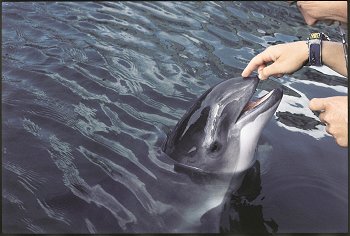Tag Archives: porpoises
Porpoise in Holland becomes 2nd to give birth in captivity
Amber, a porpoise living at the Harderwijk dolphin centre in the Netherlands, has given birth to a calf this spring, making her the second porpoise ever to give birth in captivity.
Visitors are now gathering to come and see the calf, which has been given the name Kwin.
Picture is GNU
“Mum Amber and her baby, Kwin, are doing fine,” the centre said in a statement on Thursday.
The sex of the calf has not yet been determined and will continue remain unknown for several weeks. Another conundrum concerns the paternity of the calf. According to the dolphin centre, two male porpoises were swimming with Amber at the time of conception and any of them may be Kwin’s father.
The very first porpoise ever to give birth in captivity lives in Denmark where it had a calf in 2007 and the Harderwijk dolphin centre is now enlisting the aid of Danish porpoise keepers to make sure that baby Kwin is properly cared for.
“As we don’t know much about newborn porpoises, a team of Danish minders has come to help us,” the centre says in its statement.
The porpoise is a small ocean-dwelling mammal related to whales and dolphins. There are six recognized species of porpoise and their common ancestor is believed to have diverged from the dolphins roughly 15 million years ago. Porpoises are not as large as dolphins and have stouter bodies with small, rounded heads. Compared to dolphins, wild porpoises bear young more quickly and some species give birth to a calf as often as once a year. However, porpoises do not adapt to life in captivity as well as dolphins do and successful reproduction in zoos is therefore extremely rare.
Acidified Ocean too noisy for whales and dolphins?
As we release more and more carbon dioxide from fossil fuel into the atmosphere, the world’s oceans become more and more acidic. Exactly how this will affect marine life remains unknown, but a paper published this week by marine chemists Keith Hester and his co-authors at the Monterey Bay Aquarium Research Institute is now shedding some light on how a change in acidity affects sound waves under water.
Beluga Whale
So, why is the speed of sound underwater of any interest to Monterey Bay Aquarium researchers? As sounds travel faster, the amount of background noise in the sea will increase and this could affect the behaviour of marine mammals. Many marine mammals, such as whales, dolphins, and porpoises, relay on sounds for communication and food location.
According to conservative projections by the Intergovernmental Panel on Climate Change (IPCC), the chemistry of seawater could change by 0.3 pH units by 2050. According to Hester and his colleges, such a change in acidity would allow sounds to travel up to 70 percent farther underwater in some areas, especially in the Atlantic Ocean. The paper also states that sound may already be travelling 10 percent farther in the oceans than it did a few centuries ago.
According to Hester et al, a change by 0.3 pH units by 2050 will have the greatest effect on sounds below about 3,000 cycles per second. This range includes most of the low frequency sounds that marine mammals are known to use, but it also includes a lot of sounds produced by human activity, such as boating, shipping, and certain military activities. As if acidification of the ocean wasn’t enough, the amount of underwater sound produced by human activities has increased dramatically over the last 50 years. So, even if acidification would make it possible for sound produced by marine mammals to travel farther than ever before, it might also cause these sounds to be effectively drenched by a cacophony of human generated low frequency noise. In such a noisy sea, a marine mammal’s ability to locate prey animals and a suitable mate and could be severely impinged on.
The paper will be published in the October 1, 2008 issue of Geophysical Research Letters.

